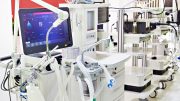The NHS was working to develop a new model of outpatient care before Covid-19, but the backlog of elective care that has built up during the pandemic has given new urgency to developments like patient initiated follow up, or PIFU.
Finding the right technology and transformation approach will be critical to the success of these changes, says Janez Bensa, chief executive of Parsek, who outlines the capabilities of the Vitaly platform.
The NHS was working to develop a new model of outpatient care before Covid-19, but this work has been given a new impetus by the pandemic and the need to tackle record waiting lists as safely and efficiently as possible, while keeping patients reassured and engaged.
The NHS Long Term Plan recognised that a lot of the work that is done in a traditional, outpatient department can be done just as effectively in other settings, by using technology to support patients at home, and for pre-op and follow-up care.
The plan called for a reduction in outpatient appointments of a third; which looked challenging until Covid-19 arrived. During the pandemic, hospitals moved quickly to implement remote working and virtual consultations; and now the health service is looking to build on these developments.
For example, the NHS England priorities and planning guidance for 2022-23 says trusts should be looking to extend patient-initiated follow-up, or PIFU, to all major outpatient specialties by this time next year.
PIFU will help to create capacity to reduce the backlog of elective care, by offering follow-up appointments only to those patients that need them or ask for them. It’s also an important building block in creating that new model of outpatient care in any diagnostic area.
Benefits for patients, clinicians and institutions
Developments like this are good for patients. Most people would rather be living active lives, away from care facilities; but they need assurance that they are being guarded. They need to feel they have all the information they need to contribute to their overall care, and that their clinical team is near to them, if they need it.
New models of care benefit medical professionals. Clinicians know that there are significant inequalities in health and in access to treatment, and they want to address them. They want ready, easy access to full patient information and data to understand their patient population and inform new care pathways.
They also want tools that enable them to deliver person-centred care, instead of being micro-managed against a contract. Finally, we know that new, integrated models of care can be good for institutions and their administrative staff, by reducing the cost and burden of administration, and generating capacity.
The potential of the solution has been recognised by the Lancashire and South Cumbria Health and Care Partnership, which has deployed Parsek’s Vitaly platform to deliver personalised, stratified follow up, or PSFU, for breast, prostate, and colorectal cancer survivors in four regional NHS trusts.
The PSFU pathway helps address that NHS Long Term Plan target of reducing face-to-face outpatient appointments by 33%, while releasing time for staff to actively manage their caseloads, perform higher value clinical activities, and focus on patients who really need their attention.
Finding the right technology platform
A new model of outpatient care will only deliver these benefits in the region if it uses the right technology. So, what should integrated care systems and trusts be looking for?
The right platform: The Vitaly solution for coordinated care has been designed with both groups of users: NHS professionals and patients. Its integrated applications enable care teams to follow their patients’ journey remotely and swap routine, time-based follow-up with needs-based clinical activities, that incorporate best practice guidelines.
Patients can receive automated reminders to perform their care activities, fill in questionnaires, and submit their own information to their care teams, which reduces the anxiety that can be associated with waiting, hospital visits, and follow-up care. This continuous, remote surveillance means that deterioration can be spotted early, and patients don’t have to wait for their next, routine appointment to flag issues that matter to them.
Vitaly is built to be intuitive and is supported by access to patient tutorials and videos. To further reduce in-person visits, patients can be connected to their care teams by secure messaging or video call.
Built to integrate: Vitaly has been built using open standards, to support the secure exchange of data from electronic patient records and shared care record systems. Care teams get full and real-time access to patient information to make more informed decisions and reduce regional inequalities.
Easy to deploy: Vitaly is cloud-based and delivered as software as a service. That means ICSs and trusts can leave security and technology management to Parsek, sign just one contract for hosting and services, and focus on provisioning and delivering the new model of care.
Secure your data: Vitaly keeps the data and application layers separate. It comes with analytical features that provide real-time insights into performance and participation. There’s an open API so data can be used by external BI tools, and a feature for anonymising data for use in planning and research.
Disease agnostic: Vitaly is already being used to develop new cancer pathways in the UK. However, the tools in the Vitaly platform are disease agnostic; they can be tailored to support a wide range of pathways and conditions.
That means ICSs and trusts don’t have to care for cancer patients through one ‘digital front door’ and patients with chronic or mental health conditions through another. They can deliver the same, high-quality service to all the patients that need it through a unified regional platform.
Focus on benefits to deliver truly transformational care
The English press is reporting that waiting lists for elective care and cancer care are at record highs and will not come down for many years. PIFU will play a critical role in reducing the timeframe over which waiting lists can be tackled.
However, PIFU is just one part of the new model of outpatient care that technology can support. Implementing PIFU as a project will help organisations, clinicians and patients; but if we are really going to transform healthcare, we need to think bigger.
We need to start with a cohort of patients that is likely to use a transformed model of care and identify the benefits that will be delivered after that transformation. We need to baseline where we are now and then measure the outcomes, so we not only capture the implementation of technology, but how it is delivering value in day-to-day care and everyday life.
Those benefits we should expect include a reduction in administrative tasks and activities like routine appointments, so staff can perform more high value activities. They should include better quality of care, by making sure there is good, current data for clinical teams. And they should include giving patients the information and tools that they need for self-care, 24/7.
The good news, from the perspective of an international vendor, is that the NHS is up for this. Central bodies, ICSs and trusts are all making the case for transformation. The issues they are looking to address are: using what budgets and using what technology?
That’s not always the case in other European countries, and it’s exciting. There’s a real opportunity to use ideas like PIFU to address waiting list and demand challenges and, in doing so, to lay the foundations for new models of transformational care.





